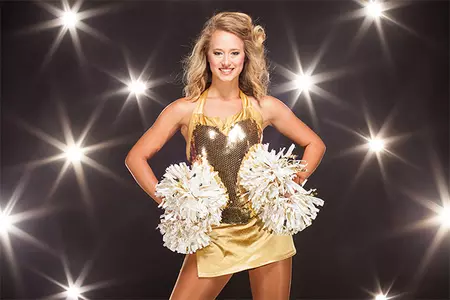
Golden Anniversary
9/17/2015 4:56:00 PM | Football, Spirit Squads
Mizzou’s dazzling dance squad celebrates 50 years.
Editor's Note: This story was originally published in the Fall 2015 issue of MIZZOU Magazine, and online at https://mizzoumag.missouri.edu/2015/08/golden-anniversary/. For more information about the Mizzou Alumni Association, please visit their website.
Few events showcase Mizzou's pageantry quite like a home football game on a glorious mid-Missouri autumn day. From the belly-punch of the ROTC cannon after a Tigers touchdown to the echoing "M-I-Z!" of 71,000 fans, traditions permeate the senses at Memorial Stadium.
In fall 2015, the Golden Girls dance squad celebrates 50 seasons at the center of it all. What began in 1965 as a troupe of seven sequined baton twirlers has grown into a nationally recognized and frequently televised dance team of 30-plus.

Senior, Dallas. Uniform era: 1980s.
Although the gilded uniforms and thousand-kilowatt smiles have been present since the inaugural season, nearly every other aspect of the iconic squad has evolved.
The 1960s were a golden age for Mizzou football. Head Coach Dan Devine led the Tigers to 77 wins and five bowl games. Players such as Johnny Roland, BS BA '66, and Roger Wehrli, BS Ed '70, electrified crowds with their gritty and athletic play. The band, dubbed "Marching Mizzou" in 1958, rode the wave of gridiron success to national prominence. Innovative Director Charles Emmons, hoping to wow the audience at the 1960 Orange Bowl, concocted elaborate halftime-show formations including the still-popular "Flip Tigers" routine: Band members form the word "Mizzou" and then transform it into "Tigers."
Celebration Time
This weekend, the Golden Girls are celebrating their 50-year anniversary as part of the football team's game vs. UConn. The celebration begins Friday night at the Country Club of Missouri, where the Golden Girls will hold a fashion show of costumes and uniforms from the last 50 years, along with a tribute to Golden Girls of past and present.
During Saturday's game, the Golden Girls have a special halftime tribute that should keep Mizzou fans in their seats as the squad will pay homage to all of those who donned the gold sequins over the last 50 years.
A small group of baton-wielding majorettes accompanied the band every Saturday. But when Sandy Davidson, BA '68, MA '73, JD '82, now a communications law professor at the MU School of Journalism, wore a silver-sequined leotard to the 1964 tryouts, the showman Emmons had a eureka moment.
"He said, 'I'd like to see that in gold!' " says Patty Gramm Kespohl, BS Ed '68, a featured twirler on the 1965 squad and Golden Girls coach for 33 years. "We weren't officially announced as the Golden Girls — maybe a reporter gave us that name — but we were always looking for twirlers until [Emmons' successor Alex] Pickard got tired of watching the girls pick up dropped batons."
The luminous uniforms, reflecting sunlight to the stadium's highest climbs, were a hit. "They were stretchy and thick, and they were hard to pull on," says Emmons' daughter Charla Emmons Kleopfer, BA '69, MA '79, an original Golden Girl. "They were modest, but they didn't look modest on the football field."

Freshman, Kansas City, Missouri. Uniform era: 1960s.
In the 1970s, the Golden Girls caught the eye of executives at the NFL's St. Louis Cardinals. For five seasons, the squad bused to St. Louis on Sundays and performed in red-and-white uniforms on the Busch Stadium sidelines. Although the paying gig helped fund uniforms and trips, Kespohl eventually decided the weekly obligation was too much to ask of college students.
In 1987, former MU Director of Athletics Joe Castiglione wanted to see more action during halftime and timeouts of men's basketball games, so he invited the Golden Girls to perform at the Hearnes Center. The closer quarters forced Kespohl to trim the roster to 14 dancers, which ultimately might have helped sharpen the squad's skills. The 1990–91 Golden Girls won back-to-back National Cheerleaders Association championships in Dallas, and the dancers were rewarded with a trip in to Tokyo, where they performed during NBA exhibition games.
"We all had 4-inch bangs and went through some serious Aqua Net," says Shannon Wells Fry, BS Ed '95, a Golden Girl alumna who enters her 18th season as coach in 2015. "It was the stickiest."

Sophomore, Columbia. Uniform era: Current.
"As a Golden Girl, I gained confidence, but I also learned the value of trying your best and being part of a team," says Linda Russell, BS Ed '72, M Ed '87, a retired social studies teacher at Columbia Public Schools. "You don't want to let your team down, but you have to have fun. Those years were some of the best of my college experience."
Golden Girls alumnae have gone on to become dance instructors, lawyers, doctors and scientists. Their beaming faces and boundless enthusiasm have welcomed and entertained many thousands of fans at Mizzou events over the years.
"Our first responsibility is to be ambassadors for the University of Missouri," Fry says. "When you become a Golden Girl, you take on the name of every single girl who wore the gold sequins before you. I always tell them, 'This is not a job; it's a lifestyle.'"

Sophomore, Kansas City, Missouri. Uniform era: 1970s.







